Ali Fujino
From Discourse 13
Studying art for decades has schooled me to appreciate the best in the field. Throughout history, the art world has had sterling examples of artists who are larger than life. We think of Da Vinci, Picasso, Warhol, individuals who do something memorable.
Tom Van Sant is that type of artist. Professionally trained he has been on the cutting edge of art and design for decades. Like the masters, he works in a way that incorporates everything in his life into his art — his personal life, his professional and technical skills and his passion to know about the world in which he lives.
Wikipedia describes Van Sant as a sculptor, painter, and conceptual artist. In his professional work he has executed over sixty major sculpture and mural commissions for public spaces around the world. These include the international airports of Honolulu, Taipei and Los Angeles, the civic centers of Los Angeles, Newport Beach and Ingle- wood, and corporate centers in Taiwan, Manila, Salt Lake City, Dallas, Honolulu and San Francisco. He had a long association with architect William Pereira and his work has adorned over a dozen Pereira buildings. Van Sant has had more than a dozen one-man exhibits in the United States, Europe and Australia. His art is represent- ed in public and private collections throughout the world.
Van Sant’s professional skills and intellectual interests span architectural design, city planning, art education and advanced technical invention. His large scale conceptual art projects of the 1980s led to the creation of The GeoSphere Project, an ambitious environmental display system designed to illustrate the issues of earth resource management.
The GeoSphere Image marks a milestone in cartographic history. It is the first satellite map of the earth, showing the real world as it appears from space. The work required one year of effort on the world’s most powerful graphics computers by Van Sant and technical director Van Warren of Jet Propulsion Laboratory, and was assisted by Jim Knighton and Leo Blume. The image was first published as the title page of the National Geographic World Atlas.
In 1992, Van Sant created an installation called “the Earth Situation Room,” an interactive project which features visualizations of earth systems and changes. This project was first shown at ECO-92, the Earth Summit, in Rio de Janeiro.
Former vice president, Al Gore, cited Van Sant for this beautiful and useful 3D image of the earth in the film An Inconvenient Truth. The list of honors, commissions, and accomplishments goes on and on.
The Drachen Foundation’s introduction to Van Sant was about 10 years ago, but last spring, on the most perfect of Santa Monica days, Jose Sainz and I visited Tom at his home and studio, across the street from the Santa Monica beach. The studio is what every artist dreams of — expansive and reasonably priced, it rambles with enough space for living and work. There are rooms for gathering, rooms for an office, rooms for crafting sculpture (welding large structural models for 40 plus foot commissions), rooms for drawing and drafting, and rooms for photographic projection. Leading off these many rooms are living quarters and a gigantic kitchen, (the space was once a roadside restaurant). It has the flavor of being a bit spartan with leaks in the ceiling that let in wind and water, but all in all, it is the artist studio that we all wish we had. It was clear to me upon visiting that this space represents the foundation of his work and vision over 30 years of his life. Now in his early 70s, Van Sant is working on major sculptural commissions and has time to revisit his kiting.

TomVanSant.com. Tom Van Sant launching one of his kite designs.
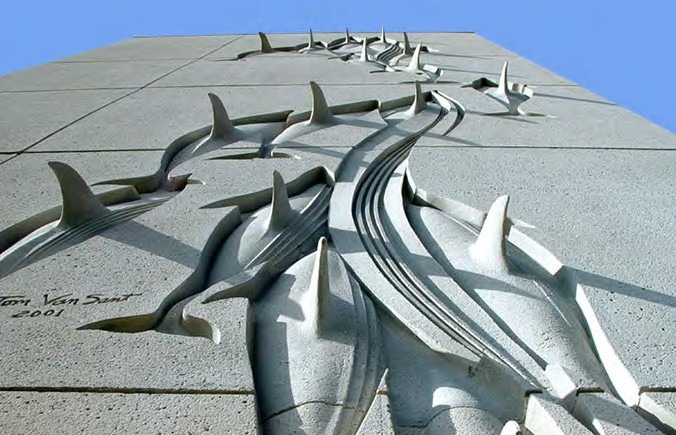
Ali Fujino. ”Dolphin’s Wall” by Van Sant, created in 2001 in sculptured concrete in Newport Beach, California.
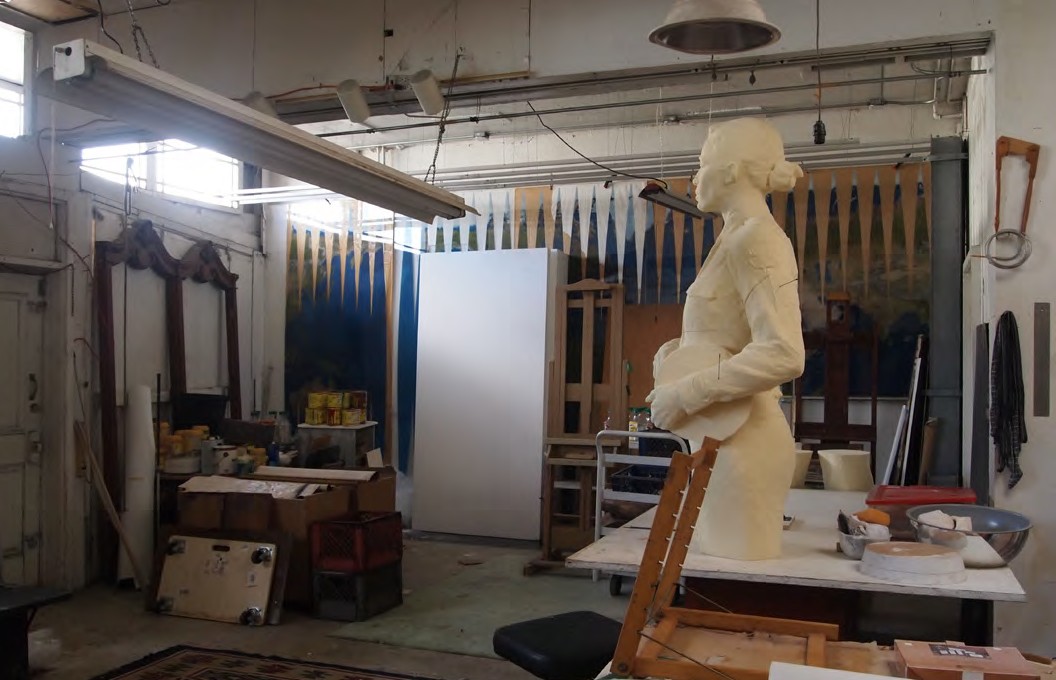
TomVanSant.com. Van Sant’s Santa Monica studio.
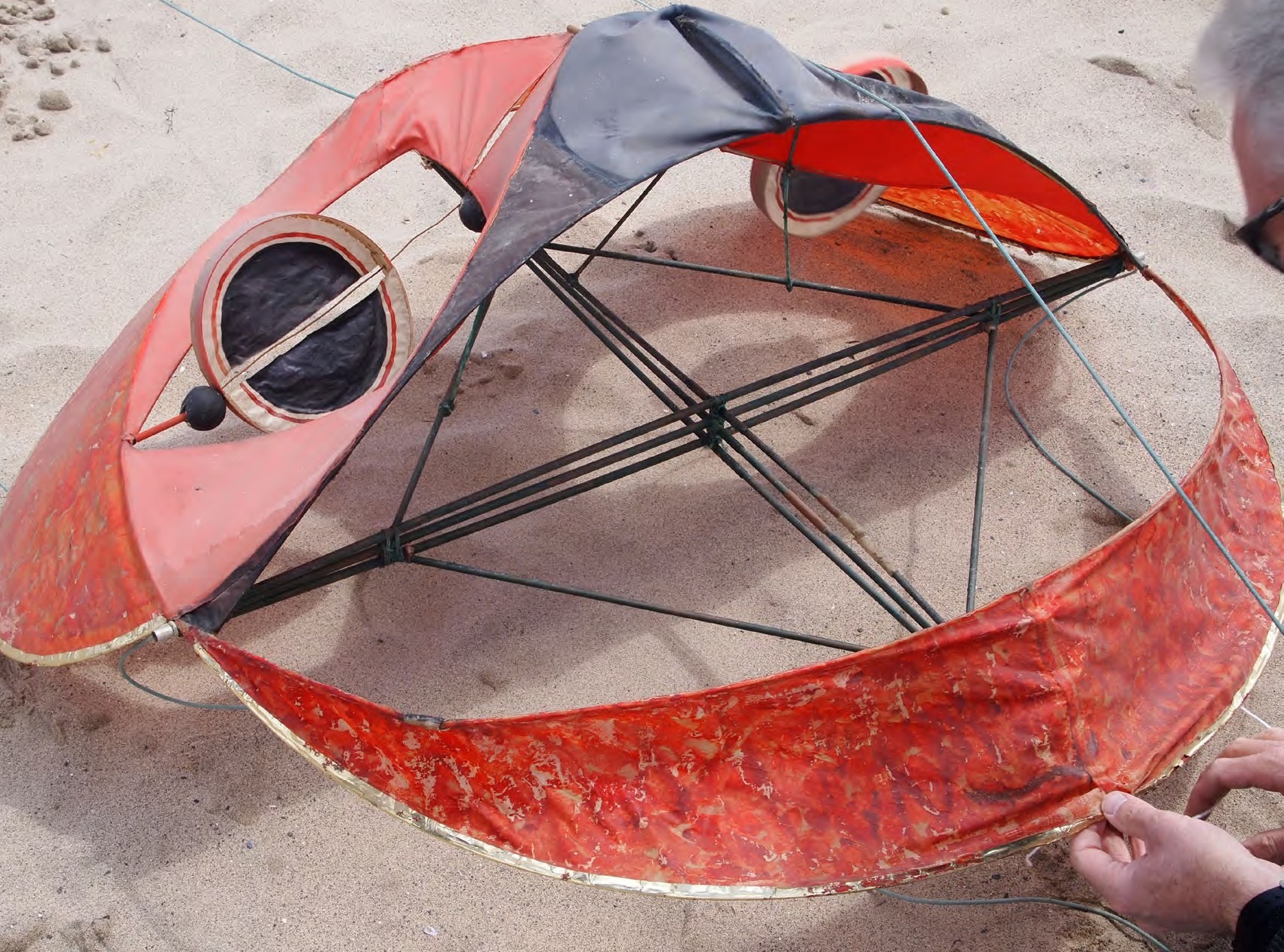
Ali Fujino. Tom Van Sant assembles one of his 40-year-old kites on the beach in Santa Monica.
The gathering that particular weekend was an impromptu invitation from the Otis College of Art and Design (Los Angeles’s first independent, professional school of art and design). Tom has taught at Otis on and off for decades, but was invited back this past spring to lecture about his kites. These are the kites that should be a primer for all kitemakers, and after 40 years, they still hold their place in kiting design and construction.
This gathering of the best kiters in the world were all there to pay homage to Van Sant. The word went out over the telephone by Tom, “I just lectured about kites to a design group at Otis, and they are keen to have a kite festival on the beach. Come!” Melanie Walker, Jose Sainz, Ken Conrad, George Peters and Suzanne Sadow were among those who came to pay tribute to him. That weekend, he opened up everything to us, and our focus was his kites.
His wonderful visions of tethered flight were translated into his own creation, and the stacks of meticulous drawings showed us how much time and work he put into each kite. Although aged and torn, his kite creations illustrated stability of flight and perfection of original design. They showed his knowledge of kiting cultures, the use of modern materials (he was one of the first to use fiberglass tubes and nylon fabric in contemporary kite construction), and the energy of one person who had vision and was not afraid to pursue that vision. They showed his intense focus on the period of his life where kiting made total sense in his work, from his sketches, to his engineering and documenting their flight through film.
We were all inspired in his presence, and after an evening of visiting, could not wait until the next day to take one of the most famous of his kites, Jacob’s Ladder (ca. 1976), for a fly. It is fashioned after a centipede kite and consists of 200 segments; 1 inches (280mm) across, each disk has three line attachments, and a stabilizing rod 42 inches (1,070mm), lifts up to 2,000 pounds, measuring ¼ of a mile in length and is promoted as being able to be “climbed by a person into the sky”. Tom designed and engineered a launching mechanism to help keep the 200 segments free of tangles as the kite rises into the sky.
The night before the launch had given us the opportunity to survey the condition of Jacob’s Ladder. Many of the nylon sails had come away from their circular frames, so it was decided the launch would only be of a portion of the kite, perhaps 35 of the segments. Even 35 would create pull. The winds that day were tremendously strong, gust- ing up to 30 mph. This was not the prime conditions for launch, but none of us wanted to be disappointed by having a no-launch day. George Peters took charge and the rest of us were satisfied to be a part of the volunteer crew. The segments were carefully laid out with consideration to the direction of the wind, and the public spectators. George was careful to note there would be much pull from even 35 segments, so we took precautions to tie the flying line to the lifeguard stand. No matter how long we waited, the wind conditions were not perfect. The command from Tom was given, and we watched Jacob’s Ladder rise and then take that rolling turn and twist. It did rise, as it had 40 years before, but the sails and framework were not holding, and as the segments began to separate, the winds continued to gust. We quickly lowered the kite and grounded the segments by placing handfuls of sand on each one.
I looked back to see Tom standing with George, with that handsome smile and a look of sheer excitement, “He went up, but time has not done him well…back to the studio for repairs.” Perhaps Jacob’s Ladder would fly another day.
If you are in the Santa Monica area on March 17th, 2013, Otis College of Art and Design will hold the second annual kite festival, and you can be sure that Van Sant will be leading the launches.
REFERENCES:
Tom Van Sant’s website: www.Tomvansant.com
Van Sant’s website for the GeoSphere Project: www.geo-sphere.com
Jacob’s Ladder in Flight, 15 minutes, 18 seconds: http://vimeo.com/26766993
Van Sant Interview, Distinguished Otis Alumni: http://youtu.be/k2CuCMaHlKY
New Scientist article from 1990. Science: Vision of a Cloud- less Planet Earth. 12 May 1990, Magazine issue 1716.
Radford, Georgia and Radford, Warren; Sculpture in the Sun, Hawaii’s Art for Open Spaces, University of Hawaii Press, 1978, 18-20, 97.
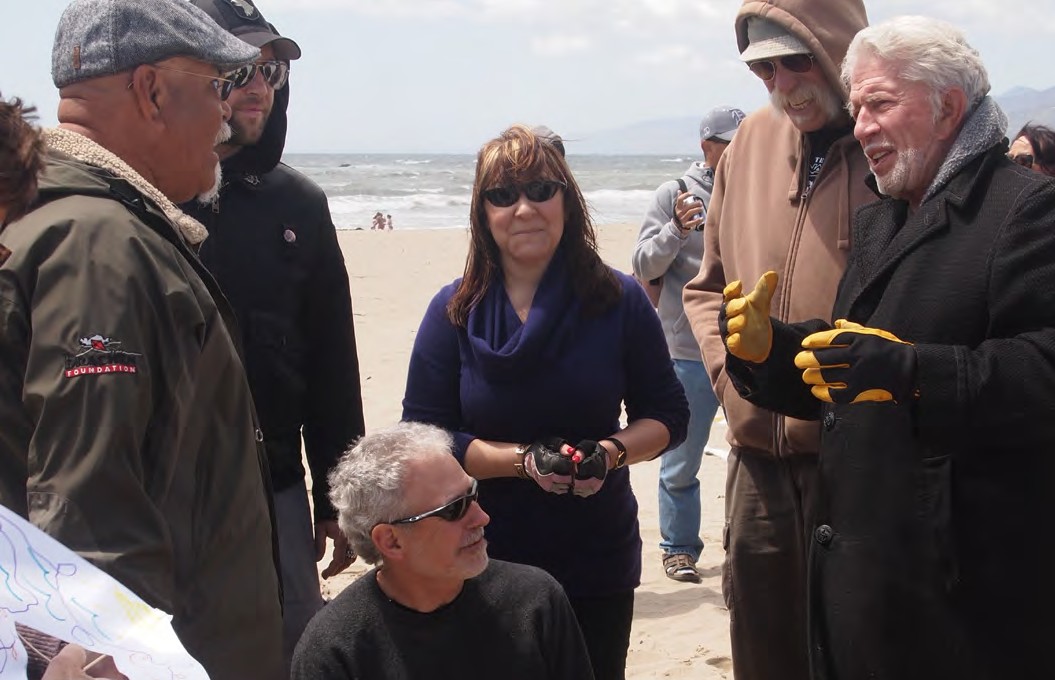
Ali Fujino. The group gathers on the Santa Monica Beach for the flight of the centipede kite. Tom Van Sant (right) prepares the group for the launch with detailed instructions.

Ali Fujino. Laying out the disks.

Drawing by Van Sant with annotations by Ron Moulton.
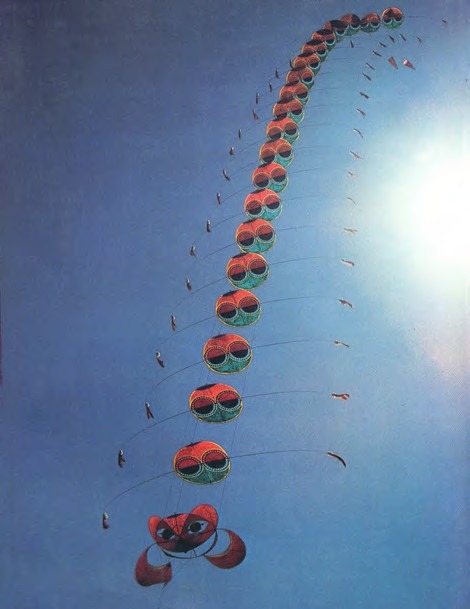
Van Sant’s kite, Jacob’s Ladder, adorns the sky.

